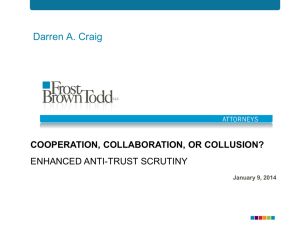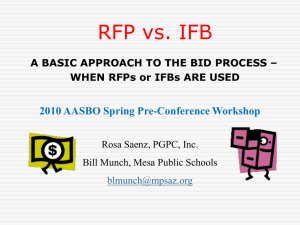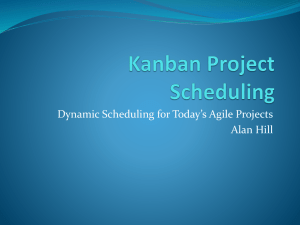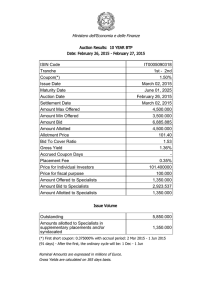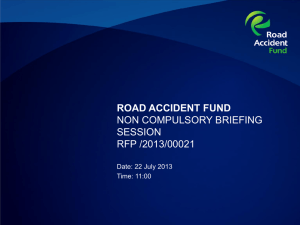Panel on Unbalanced Bidding Procedures
advertisement
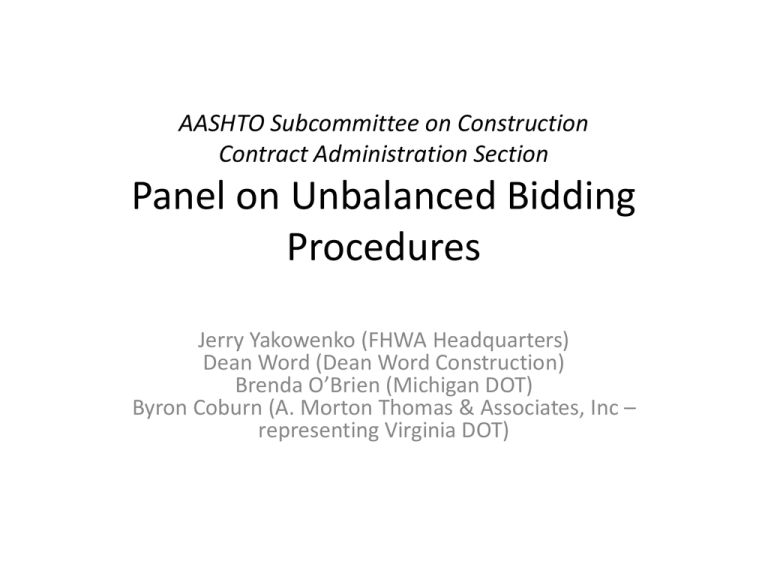
AASHTO Subcommittee on Construction Contract Administration Section Panel on Unbalanced Bidding Procedures Jerry Yakowenko (FHWA Headquarters) Dean Word (Dean Word Construction) Brenda O’Brien (Michigan DOT) Byron Coburn (A. Morton Thomas & Associates, Inc – representing Virginia DOT) Background – Bid tabulation and bid reviews are an important part of ensuring a transparent, fair and competitive procurement system. – While the frequency of unbalanced bids is relatively rare, unbalanced bidding reviews are an important step in the letting and award process. FHWA Regulatory Policy • Definitions (23 CFR 635.102): – Mathematically unbalanced bid means a bid containing lump sum or unit bid items which do not reflect reasonable actual costs plus a reasonable proportionate share of the bidder's anticipated profit, overhead costs, and other indirect costs. • Materially unbalanced bid means a bid which generates a reasonable doubt that award to the bidder submitting a mathematically unbalanced bid will result in the lowest ultimate cost to the Federal Government. FHWA Regulatory Policy (continued) • 23 CFR 635.114 Award of contract and concurrence in award. – “ (c) Following the opening of bids, the STD shall examine the unit bid prices of the apparent low bid for reasonable conformance with the engineer's estimated prices. A bid with extreme variations from the engineer's estimate, or where obvious unbalancing of unit prices has occurred, shall be thoroughly evaluated. – (d) Where obvious unbalanced bid items exist, the STD's decision to award or reject a bid shall be supported by written justification. A bid found to be mathematically unbalanced, but not found to be materially unbalanced, may be awarded. – (e) When a low bid is determined to be both mathematically and materially unbalanced, the Division Administrator will take appropriate steps to protect the Federal interest. This action may be concurrence in a STD decision not to award the contract. If, however, the STD decides to proceed with the award and requests FHWA concurrence, the Division Administrator's action may range from nonconcurrence to concurrence with contingency conditions limiting Federal participation.” 2004 AASHTO SOC CA Section Survey 1) Does your state have written procedures for determining when a bid is materially unbalanced? 2) In the past three years, how many times has a bid been declared to be materially unbalanced? 3) What was the disposition of these circumstances? 2004 Survey (continued) • 27 State DOT responses were received by the FHWA Office of Program Administration. • From 2001-2003: – – – – twelve states did not declare a bid to be materially unbalanced, eleven states had between 1- 4 materially unbalanced bids, two states had 5 –10 materially unbalanced bids, and two states provided a not applicable response. • From 2001-2003 states responded to irregular bids in the following manner: – eleven states rejected all bids and readvertised, – four states indicated that they declared the irregular bid non-responsive and awarded to the lowest responsive bidder, and – ten states responded with not applicable reply. 2004 Survey (continued) • Seven State DOTs (CA, FL, NC, NV, TN, TX and WI) provided their formal procedures for evaluating unbalancing. – Florida DOT’s procedure includes the use of an “Unbalanced Bid Item” program that utilizes a bell curve distribution to develop a statistical average unit price for comparison purposes. – TxDOT’s procedure analyzes: • unbalanced prices that vary from the estimate outside a specific range. • utilizes a comparison of the balanced vs. unbalanced monthly payout rates • calculates monthly payout during the life of the contract based on an assumed schedule. – Wisconsin DOT Construction and Materials Manual, Section 2.10.2.1 Unbalanced Bid Analysis, defines significant item and provides a procedure for reviewing unbalanced bids: http://roadwaystandards.dot.wi.gov/standards/cmm/210.pdf • Link to the 2004 Survey Summary: • http://construction.transportation.org/Documents/2004surveyonmateriall yunbalancedbids.pdf Caltrans – Low Bid vs. EE and Average Number of Bidders http://www.dot.ca.gov/hq/esc/oe/download.php?id=cprchart The Contracting Industry’s Perspective Dean Word (Dean Word Construction) A State DOT’s Perspective (Michigan) Brenda O’Brien (Michigan DOT) Unbalanced Bids Michigan DOT Practices AASHTO Subcommittee on Construction August 17, 2010 Brenda O’Brien, Michigan Department of Transportation Unbalanced Bids – Michigan DOT Audit Finding – Lacking a documented review of bids for unbalanced unit prices Unbalanced Low Bid Management Review Team (ULBMRT) established April 2009 Reviews every letting Identifies potential materially unbalanced bids Unbalanced Bids – Michigan DOT Project Selection All projects over $5 Million AND Random selection of 1/3 of all projects let Screening Criteria Line item +/- 15% from engineer’s estimate Engineer’s estimate line item amount of +/$1000 Secondary screening: Contractor’s historical bids for respective line item Bid Item Analysis Check Unbalanced Bids – Michigan DOT First year results 21 lettings 353 contracts reviewed 65 contracts sent for further field review 7990 line items reviewed No individual bids rejected Two letters of clarification Two projects pulled, corrected, and re-let A State DOT’s Perspective (Virginia) Byron Coburn (A. Morton Thomas & Associates, Inc – representing Virginia DOT) Unbalanced Bids Byron Coburn, PE AMT Associate Former State Construction Engineer August 17, 2010 VDOT History VDOT has not rejected a bid for being unbalance in over 10 years. VDOT’s methods have to date overcome the need to reject for unbalance. VDOT awards between 400 to 600 road work contracts per year. Nearly all contracts are unit priced type contracts. The actual number of units used during construction multiplied by the unit price is what the contractor is paid. However, VDOT does use some lump sum pay items but there use is limited. How VDOT Estimates Just prior to receipt of bids, VDOT performs a rational (real world) estimate. The estimator puts together a virtual crew, gets quotes on materials, adds transportation cost, etc; mimicking what a contractor would do. This is done on all but very simplest of projects. This Engineer’s Estimate becomes in essence VDOT’s “bid” for the project. This is the estimate used to determine good value. The low bid should be within 7% of EE to be considered acceptable. When it is not, VDOT seeks to know why. Since VA Code allows for negotiation to bring price within the budget, and is otherwise silent to the analysis of bids, VDOT can ask the contractor questions about how he prepared his bid. It should be noted that there is no actual negotiations during this analysis; merely discovery. Therefore, federal regulations are not violated. The bids are examined primarily for ultimate value (or materially balance); and are primarily focused on the bottom line. Memorandum of Understanding (MOU) If an unusual unit price is detected that suggests a mathematically unbalanced bid, the contractor is asked to explain why he priced the item that way. After meeting with the bidder, the VDOT estimator may consider the information gleaned from the contractor to re-price the item, and again makes a comparison. If the price is still outside acceptable range, VDOT usually uses a Memorandum of Understanding (MOU) to limit exposure to overruns. A MOU is a supplement to the contract signed by the contractor and the Department, outlining the terms of the agreement related to unbalanced item. Usually the MOU will limit the payment of the bid unit price to the quantity listed in the schedule of items. Any additional units (overruns) are agreed to be supplied at a new established price that is priced at the current market price. MOUs are used on about 25 times per year. A MOU can also limit the Contractor’s risk to underruns if desired. Zero or Penny Bids VDOT will accept a zero or penny bid as a legitimate bid if the contractor can explain and demonstrate why he priced the item that way. The reason could include that the cost was included in other related items, the cost is being paid for on another project, there is no intrinsic value for that work, the contractor’s methods eliminate the need for that work, etc. Example: On a recent Woodrow Wilson Bridge project, the Contractor bid a penny on traffic control barrels. He had figured his total traffic control cost for the project, and it was his company’s practice to covered that cost in his traffic barrels. He explained that he was concerned that the quantity shown in the schedule of items would not actually be used, so he would not recoup his cost if indeed the barrels underran. His strategy instead was to added his traffic control cost to his mobilization and place no cost on the barrels. VDOT noted this in the MOU so the contractor could not later claim that he made a mistake. Zero or Penny Bids Example: The contract calls for allying dust thru water truck hours. The contractor plans to control dust with calcium chloride, the cost for which he places in another item. Example: A contractor is currently working on an adjacent project that has surplus earthwork. He bids .01 for borrow on the new project because he is being fully compensated for disposal on the current project. This will likely ensure he is the low bidder. Unusually Low Bids When the bottom line price is below the EE by 25%, and there is a 25% difference between 1st and 2nd bidders, VDOT will allow the low bidder to withdraw without penalty if the contractor has made a mistake. If the 1st bidder wants to withdraw his bid, the 2nd bid is analyzed in the same fashion. If the 2nd is deemed a good value, VDOT may make award to the 2nd. Rejection of Bids & Re-advertisement State law gives the agency the right to reject all bids if deemed in the best interest of the Commonwealth for any reason other than to eliminate a particular vendor. Re-bids in competitive markets usually result in lower bids with the next advertisement. Last year VDOT saved about $8 million by re-advertising projects where bids exceeded the estimate. The saving is primarily due to identifying the risk through the discussions with the contractor, and then mitigating that risk in the second advertisement. Questions? Should be directed to ; Don Silies State Contract Engineer At email address Don.Silies@VDOT.Virginia.gov
